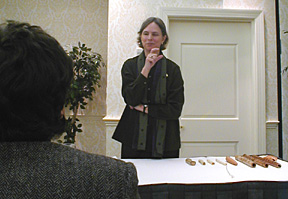Music may be universal, but the explanation why could have a Western bias, Cornell psychologist finds
By Bill Steele

Every human culture makes music. It makes people happy or sad, calm or angry. It is used for work and play, for education and celebration. "The variety of music found cross-culturally suggests a deep human need to create, perform and listen to music. But, why?" asks Cornell University professor of psychology Carol Krumhansl.
One important reason, she and other psychologists believe, is that we have certain expectations about what will follow next in the melody. The emotional response to a melody depends on whether, when and how the expectations are fulfilled, Krumhansl suggests. Krumhansl described research that partially confirms and partially questions a recent theory about how these expectations work at the annual meeting of the American Association for the Advancement of Science (AAAS) in Washington, D.C., today (Feb. 20). Her talk was part of a panel session titled "Bio Music: The Music of Nature and the Nature of Music."
The idea that musical enjoyment is related to expectations has implications for those creating, performing and listening to music, Krumhansl believes. When something unexpected happens, it heightens our interest. For example, she says, "A particular point in a melody may be poignant because an unexpected tone occurs. A performer lingering on it is saying to the audience, 'Yes, this I what I mean.' I think this has pedagogical implications. It can help a student understand the effect of pausing somewhere or giving emphasis at a certain place."
While some expectations are based on experience with music, Krumhansl noted, there may also be others that are "hard-wired" into all human beings. A theory about how this works, called the "implication-realization model," was proposed by Eugene Narmour, a music theorist at the University of Pennsylvania. It predicts some specific expectations everyone should share, based on known principles of human perception. For instance, Krumhansl said, the model predicts that "if you have a small interval you expect the next interval to be fairly small. If you hear a small ascending interval you expect another ascending interval. But if you hear a larger interval you expect the melody to reverse and fill in the gap."
By working with colleagues in Finland, Krumhansl was able to test this idea across differing musical cultures. She worked with Jukka Louhivuori, Petri Toiviainen (cq), Topi JŠrvinen, Pekka Toivanen (cq) and Tuomas Eerola from the University of JyvŠskylŠ, Finland, and Annukka Hirvasuopio from Utsjoki and the University of Tampere, Finland. Petri Toiviainen is a Fulbright visiting professor at Cornell this year.
In one test the researchers used Finnish spiritual folk hymns associated with the Beseecher religious sect in southwest Finland. They compared two groups: members of the sect who had learned the hymns used in the test from childhood, and Finnish music students of the same general cultural background but unfamiliar with the particular hymns used in the test. The test consisted of playing part of a melody, then asking subjects to choose which of several possible continuations fit with their expectations.
Sect members who already knew the hymns were more likely to choose continuations that matched the actual melody than were the students. This isn't as obvious as it sounds, Krumhansl said, cautioning that we should not judge on the basis of our western musical experience. "It's an oral tradition, not written," she explained. "Different villages sing different versions. You may have people sitting next to each other singing slightly different versions."
Further, when analyzed statistically, the responses of both groups partially confirmed the predictions of the implication-realization model. "This finding is consistent with the idea that these are basic psychological principles and independent of learning," the researchers said in their paper.
But in another test, they found a small deviation. This test used songs called yoiks, sung by the Sami, people of the northern Scandinavian Peninsula and Russia's Kola Peninsula This test used three groups: native Sami, including a number of well-known yoikers, Finnish music students who knew some yoiks, and Western music students. The fit with the implication-realization model was better with the Western students, suggesting that the theory may not be quite so universal, but may have a Western orientation, the researchers said.
Questions were also raised by computer simulations on neural networks. These are computer models that can be "trained" by repeated exposure to patterns. Petri Toiviainen trained one neural network with Finnish folk songs and Lutheran hymns and another with some of the specific songs used in the human tests. When the two networks were exposed to the hymn excerpts their responses were like those of humans. Similar results were found with yoiks. This, the researchers said in their paper, could mean that so-called bottom-up principles could be derived from exposure to music, rather than hard-wired into humans. At the same time, analysis of music shows that music generally follows the principles. "So, we may create music to fit with
perceptual principles," Krumhansl explained. "Cross-cultural comparisons using behavioral, computational, and musicological methods can help untangle the contributions of mind and culture."
The research on Finnish folk hymns will be published during the coming year in the journal Music Perception, as "Melodic expectancy in Finnish folk hymns: Convergence of behavioral, statistical, and computational approaches." The study on yoiks will appear in the journal Cognition as "Cross-cultural music cognition: Cognitive methodology applied to North Sami yoiks."
Media Contact
Get Cornell news delivered right to your inbox.
Subscribe